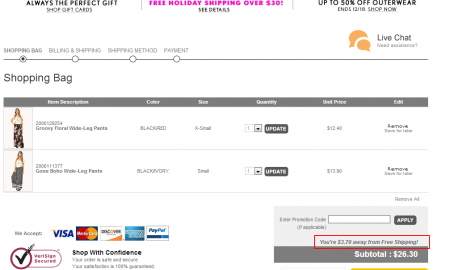Every major eCommerce blog has a post about how free shipping is a must. A must, in order to retain customers and drive sales. And I won’t lie, I have personally advocated free shipping to a lot of merchants. I mean, why wouldn’t I, it’s an eCommerce must…right?
What if I told you that offering up free shipping willy-nilly is not as profitable as you may think?

Yes, I said it. While free shipping does indeed attract customers, making it profitable is the key. One of the biggest mistakes that small online businesses can make is to offer free shipping all year round, on every product they have, thinking this will drive sales – and profits – through the roof. Especially without assessing their profit margins and offering speedier shipping options. So how do you make it profitable?
As most eCommerce 2017 Trends posts will tell you, it’s no longer just about just free delivery, it’s about faster delivery. In other words, although online shoppers expect free shipping, they are willing to pay extra for faster delivery (Thank you, Amazon Prime).
If customers expect free shipping, but are willing to pay for speedier delivery, have we been looking at free shipping positioning all wrong? And if free shipping is not as profitable as everyone (or almost everyone) is saying, then… what?

Don’t panic, we’ve got this! The first thing to do, if you’re already offering free shipping or are a new store looking for profitable shipping options before you launch, is to go back to the basics and do your math.
Four Things to Consider Before Adjusting or Adding Shipping Options
Your Profit Margins:
Before you can decide on what, if any, shipping discount you can offer, you need to take a hard, long look at your profit margins. In all likelihood your margins will vary from product to product, and you will need to factor in shipping costs for each of them. How does this affect your shipping costs? If you’re in a highly competitive niche where prices are competitive, factoring shipping expenses into the cost of an item could drive the prices above what your competitors are offering. Meaning, you will have to absorb shipping costs and therefore your margins will be lower.
Your Stock:
What are you selling? How big and how heavy is your stock? The larger and heavier your products are, the more expensive your shipping costs will be. If your products vary in size and weight, can you really afford to offer free shipping on all your products?
Your Customers:
Where are most of your customers situated? If you have recently decided to increase sales by shipping internationally, international delivery could be chewing up your products. Look at your customer locations and the areas you are shipping to, and work out your profit margins on these locations.
Your Orders:
If you’re a viral product store selling one product, you may be more inclined to be selling one product at a time with little upsell opportunity. For most stores though, the eCommerce goal is to: upsell, upsell, upsell! Multiple ordering and upselling will affect your shipping costs – the more you sell at one time the less your profits will be eaten up by shipping costs. Look at your average order amount and your profit margins: What would be the optimal dollar amount that would make free shipping profitable?
Need some help with the numbers? Try this handy, free Shipping & Profit Calculator from Shivarweb.
And now, some alternative ways you can work with free shipping to make it more profitable for your online store…
Paid Shipping With a Product Upsell
A couple of weeks ago I came across a Facebook video that had a novel idea. Instead of offering free shipping, work out the costs of providing a free product instead. Say you’re selling clothing online. It may be cheaper – and more appealing to your customers – if they paid for faster delivery, but got a free T-shirt in with the deal. Then you could even take it a step further by upselling the shopper to something that goes with the free T-shirt you have just given them.
Free Shipping Thresholds
A common way to tie in free shipping and upselling without breaking the bank is to offer free shipping on a certain sales threshold. You can do this by taking your average order value and testing free shipping on orders that are a bit higher. A study revealed that on average, 58% of shoppers will add more items to their cart to qualify for free shipping. In an eCommerceFuel podcast, Bill D’Alessandro of RebelCEO.com discussed just that:
“You’ve got to set your threshold for free shipping above your average order value, but then you got to let people know where that threshold is and how close they are to it. If you go to NurtureMyBody.com add something to your cart and then view your cart, you’ll see a banner across the top that says, ‘Wait. Add $ 40 to your cart, receive free shipping.’”
https://blog.storeya.com/wp-content/uploads/2017/02/EP112ECOMMERCEFUEL-1.mp3

Upsell Faster Delivery
As mentioned above, customers are willing to pay for faster delivery. Yes, free shipping is a draw card, but if they are willing to pay for faster delivery, are you offering it to them? Upselling faster delivery at the checkout stage is a great way to let your shoppers know that they can get their item a lot faster for a nominal fee which would cover your shipping costs and leave your profits intact.

Invest in Shipping Tools, Apps and Integrations
In an ecommercenews.eu article, Vice President of Nordic software company EDI Soft Steffen Pasgaard was quoted saying the following:
“I think online retailers accept the economic loss in providing free shipping because they don’t know the tools, which can calculate individual shipping prices based on the customer’s shopping cart and shipping address and thereby show several delivery alternatives.”
Tools such as Shipstation make it easy to ship your eCommerce orders with the carrier of your choosing, and if you use more than one carrier they’ll also show you which option will cost less! Or can you use real-time shipping costs in your shopping carts, which let’s your customers pay exactly what shipping would cost you. This will allow you to adjust shipping based on location and delivery date, without it affecting your bottom line.

Offer Free Shipping for Returns
If your online business just can’t cover the costs of free shipping yet, why not offer it other ways, keeping your margins intact. Offering a free shipping return incentive means you’re only covering the costs of shipping if someone decides to return a product. This will also instill another level of trust when dealing with a new customer.

Make Free Shipping a VIP Perk
Leverage free shipping as a way to grow your loyalty, member, VIP or returning customer programs. Give away free shipping coupons to your VIP customers, or offer a member sign-in that gives customers free shipping for a year. This will not only gain you lifetime customers – which is THE coveted eCommerce goal – but will help keep shipping costs low while offering online shoppers rewards and incentives.
Or, why not use your Coupon Pop box to offer discounted shipping coupons for VIP member signups?
Bonus Tip: Re-Negotiate Your Shipping Fees
Geek Bud store owner offers some tips, as a seasoned eCommerce shipper, on how you can lower your shipping costs, which in turn means a higher percentage of profits.
Have questions or shipping suggestions of your own for other store owners? Share them below!
Digital & Social Articles on Business 2 Community(104)
Report Post




